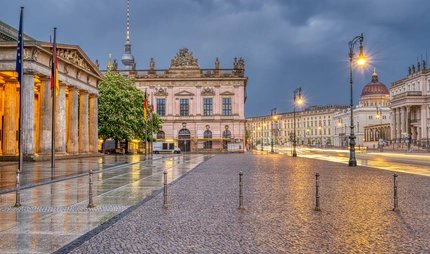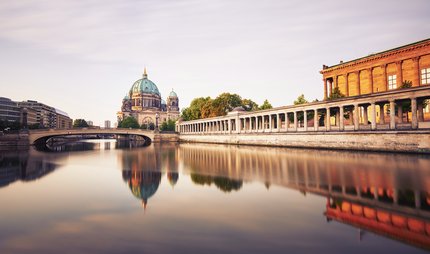
Humboldt Forum
A spectacular location for art, culture and science in Berlin
The Humboldt Forum is located in the centre of Berlin, directly opposite Museum Island: A special place for everyone, and so much more than a museum!
In the historical centre of the capital, embedded in the historical urban landscape of Museumsinsel awaits you, Berlin Cathedral, and Nikolaiviertel, an open-world forum for culture, art and science.
Concrete and Baroque
The Humboldt Forum in Berlin Mitte extends over an area of around 30,000 square metres and is visible from afar. The reconstructed baroque palace façades on the northern, southern and western sides of the Forum shine in bright quince yellow. The eastern side of the Forum on the banks of the Spree is surprising: a modern, smooth exterior façade, with the “Spree balcony” viewing platform in front and a large terrace just above the surface of the water on the riverbank.
The architecture of the Humboldt Forum clearly thrives on a contrasting combination of ultra-modern building elements and the reconstructed sculptural façades of Berlin’s former Baroque palace. The creator of this particular design and architect of the Humboldt Forum is the Italian architect Franco Stella. He won the competition for the reconstruction in 2008.

A place for inspiration, action and exchanging ideas
What awaits visitors when they pass through one of the mighty portals?
First of all, two large city squares that are open for urban life: the large Schlüterhof with Lebenswelten Bistro, Experience areas and visitBerlin Tourist Information, and the Passage, a wide colonnade path that runs right through the building.
You have a fantastic view of Museum Island, Alexanderplatz and many other sights from the roof terrace of the Humboldt Forum. Visit the upscale Restaurant Baret, where you can combine the sweeping view over Berlin with the enjoyment of culinary delights.
The interior of the Humboldt Forum impresses at first glance: A wide foyer on the ground floor connects high-rise modern gallery walls with the reconstructed palace portal. Here stands the "Cosmograph", a 17 metre high media tower and quick-change artist: it not only radiates information, but can also mutate into a gigantic art and light installation at any time.

Visitors pass through the foyer to reach the museums and special exhibition areas.
Immerse yourself in the history of the site
In the sculpture hall on the ground floor, the original sandstone figures of the castle façades can be viewed close up. And on the southern side of the Humboldt Forum, a 28-metre-long video panorama is on display, vividly illustrating the historical development of the site – since the earliest dated evidence from the 12th century. Visitors can really immerse themselves in the history of the location in the palace cellar, where the remains of the medieval Dominican monastery and the foundations of the palace have been uncovered.
The Berlin exhibition: Berlin from new perspectives
On the first floor of the completely wheelchair-accessible building, the Berlin exhibition offers a surprising special view of Berlin: And it’s not only global developments that have influenced and shaped Berlin that come into focus here. It also asks what impact Berlin has had on the world and what inspirations emanated from this city – and it does this interactively with the help of its visitors. Imaginative media and the World Studio, where personal experiences are shared, present the city as part of a diverse and globally-networked community.
The Humboldt Laboratory: a living workshop of ideas
Science and cutting-edge research on global challenges – not from a distance, but up close and tangible: the Humboldt Laboratory, a project of Berlin’s Humboldt University, is a workshop for all those who want to take part in the process of scientific research and discuss global problems and challenges: Climate change, environmental destruction, species extinction and major societal issues. Right at the entrance to the Humboldt Laboratory, visitors are immersed in the world of research via the large model of a school of fish, symbolic of collective intelligence.
Spectacular: Ethnological Museum and Museum of Asian Art

Chinese court art, richly decorated houses from Oceania or a throne from the Kingdom of Bamum/Cameroon - around 20,000 aesthetically outstanding exhibits from the 5th millennium B.C. to the present day have been presented on 16,000 square metres on the second and third floors of the Humboldt Forum: in the Ethnological Museum and the Museum of Asian Art.

But the unique artefacts do not only present the fascinating traditions of other cultures. A special curation method also addresses the circumstances under which they were taken from indigenous communities and the dilemma of the actors on the ground, in short: the difficult history of colonialism and the role of Europe with its after effects felt up to the present day.
In the large exhibition area of the museums in the east wing collection presentations on North, Central and South America can be seen, as well as another part of the object collection on Asia and Africa with highlights such as the exhibition area on the global diversity of Islam and the historical Kingdom of Benin.


No conventional museums
The exhibitions also feature the positions of contemporary artists who either directly refer to the objects on display or deal with them. Also unusual are the sound installations in a special elliptical listening room, which were created on the basis of ethnomusicological research.
Highlights
- Outrigger boat of Luf Island (1890-1895), Papua New Guinea
- Kangaroo tooth chain (before 1875), Australia
- Township Wall (2001/2018), António Ole
- Processional bull Nandi (17th century), South India
- Kizil Cave (6th-7th century), Xinjiang, China
- Lienzo Seler II / Coixtlahuaca II (16th century), 16 sqm cotton cloth, Mexico
History of the site
The two large buildings which previously stood here, one after the other in the 20th century, are a testament to it:
The history of the Humboldt Forum site is symbolic of significant disruptions and upheavals - and Berlin’s eventful history. For many centuries, the magnificent baroque city palace of the Hohenzollern dynasty stood precisely on this site, continually expanded and modified. After it lost its importance when the monarchy came to an end in 1918, it suffered major damage during the Second World War and was demolished in 1950 by order of the GDR leadership. In the 1970s, the GDR government then built its Socialist Palace of the Republic here, which suffered a similar fate after reunification: deprived of its political significance, it fell into disrepair and vanished from the centre of Berlin when it was dismantled in 2008 to make way for the construction of the Humboldt Forum.
But the history of the Humboldt Forum is much, much older than that.
Over 800 years ago...
In the 13th century, the first houses of the medieval twin city of Berlin-Cölln were built on the grounds of the Humboldt Forum. From 1300 onwards, numerous houses were demolished to make room for the construction of a large Dominican monastery. Its archaeological remains are exhibited in the palace cellar of the Humboldt Forum next to the foundations of the baroque palace.
In 1415, the first members of the Hohenzollern dynasty came to the city. In the following decades, they made their claim to power unmistakably clear to the citizens of Berlin: Elector Friedrich II began building the first palace in the heart of Berlin – against the resistance of the population, who did not want to swap their town for a royal residence. In 1448, they vented all their resentment on the palace’s construction site in a protest:
The Berlin Unwill 1448
A day in medieval Berlin that has gone down in history as the Berlin Unwill: an angry crowd of people gathered at the palace’s construction site and loud shouts resounded. Then, wielding axes and picks, they energetically took to the dam that protected the construction site from being flooded by the Spree. The angry citizens destroyed the dam and masses of water from the Spree flooded the palace square. A success – but only in the short term: penalties were imposed and the palace continued to be built.
Around 500 years of Hohenzollern rule
For half a millennium, Berlin was firmly bound to the Hohenzollern dynasty. And just as the rule of the Hohenzollern dynasty continued to expand – they were kings in Prussia from 1701 and German emperors from 1871 – the city palace was also continually expanded and modernised.

The setting of the Humboldt Forum: historical upheavals after 1918
In 1918, after many centuries of monarchy, the empire came to an end. And the site of today’s Humboldt Forum is once again the focal point of events. The consequences reached far beyond national borders: On 9 November, Karl Liebknecht, accompanied by a large number of demonstrators, proclaimed the Socialist Republic in front of the Hohenzollern Palace. By this time the imperial family had long since fled Berlin and retreated to Potsdam for the time being.
Over the next few years, the palace became home to a wide variety of political, social and cultural institutions – even a student dormitory and a soup kitchen were housed here.
After the Second World War, the palace, destroyed by bombs, was then located in the Soviet Occupation Zone and later on the soil of the newly founded GDR. The new GDR leadership identified the vast site in the heart of Berlin as an ideal location for a symbolic act: the demolition of the palace ruins was intended to erase the memory of the site’s history. The Palace of the Republic was constructed in its place: a multifunctional building which housed the seat of the GDR government for several decades.

This also faced its own downfall after reunification.
The new Humboldt Forum is a cosmopolitan place of discussion and exchange at a location where the history of Berlin and Germany is reflected and consolidated and which has had a highly symbolic character throughout the centuries.
Opening hours
Exhibitions:
Wednesday to Monday 10.30 a.m. to 6.30 p.m.
Tuesday closed




